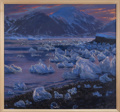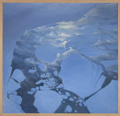Welcome to Painting at the End of the Ice Age, featuring landscape paintings by Cordova-based artist David Rosenthal. I’m Rachel Boesenberg, Assistant Curator here at the Anchorage Museum, and I’ll be narrating your audio tour as we look at paintings of glaciers and ice across Alaska and beyond. As you move through the exhibition, there will be stickers indicating places to pause and click play on the next audio segment. The numbers on the stickers correspond to the numbers on this webpage. Each audio segment is 1-3 minutes long, totaling about 15 minutes of narration. You’re invited to listen and look at your own pace. And if you do not have headphones, please hold your smartphone to your ear while listening.
The paintings in this exhibition feature scenes of glacial and sea ice from Canada, Greenland, Antarctica, and across Alaska. From the city of Kaktovik on the northern coast of Alaska to Mendenhall Glacier near what is now known as Juneau in southeast Alaska, these lands have been stewarded and cared for by Alaska Native peoples, including the Inupiat, Athabascan, Sugpiaq, Eyak, and Tlingit.
David’s paintings document retreating glacial ice and dramatic post-glacial landscapes observed during his 45-year painting career, a period coinciding with what he considers to be the final years of our current geologic Ice Age. His fascination with glaciers began when he moved to Alaska in 1977, and he’s been chronicling their retreat ever since. The 67 paintings in this exhibition are based on information from historical and scientific texts, as well as extrapolation from his own observations, memories, photographs, and drawings done in the field.
Before we make our way into the exhibition, I invite you to look closely at this painting of Surprise Glacier, which is located about 50 miles southeast of Anchorage. What do you notice? What colors do you see?
Surprise Glacier is the most active tidewater glacier in Prince William Sound. This means that its terminus meets the ocean, and the tide brushes against the face of the glacier, which calves icebergs into the water. We see this meeting of ice and water in David’s painting. In the foreground, calm, dark blue water is interrupted by ripples in the lower left, and light blue, bobbing icebergs are scattered throughout. The glassy water shows the reflection of the glacier face towering above. In the middleground, glacial ice juts upward, revealing jagged peaks and crevasses. On the left, the valley wall (which is identifiable by the rocky outcrops showing through the snow) extends beyond the frame. At the top of the painting, we see snowy mountains and wispy clouds, and the artist’s color palette shifts to silvery whites and grays.
David’s use of various shades of blue allows him to convey the complexities of glacial ice. Glaciers are made of frozen water and often appear blue. The color changes depending on weather, ice density, surface conditions, debris, and sun direction. The more transparent the ice, the more the light penetrates, and the more it is filtered, appearing deeper blue or even black.
In this cloudy scene, Surprise Glacier appears a sapphire blue. Look out for an array of glacial colors in Painting at the End of the Ice Age, including greens, pinks, purples, and oranges. You will also notice that many of the paintings are stacked with one painting placed directly above another. This allows David to show how a particular landscape has changed over time.
Please make your way from the elevator lobby to the first gallery, near the audio tour location 2 sticker.







